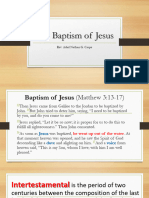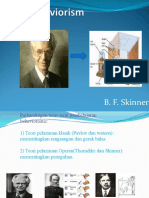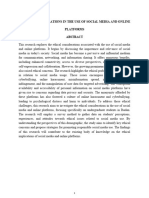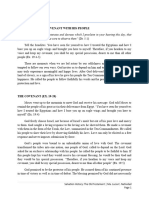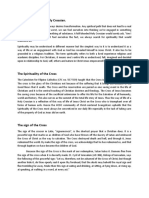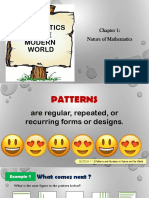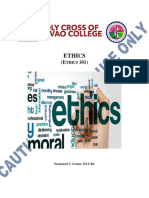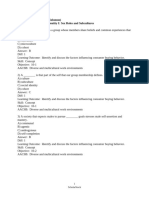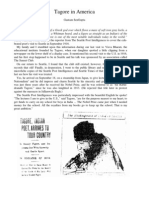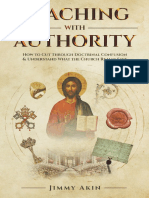Syllabus 101
Uploaded by
BRENT THEA ALVEZSyllabus 101
Uploaded by
BRENT THEA ALVEZHOLY CROSS OF DAVAO COLLEGE
VICE PRESIDENT FOR ACADEMIC AFFAIRS OFFICE
Main Campus: Sta. Ana Ave. corner C. De Guzman St., Brgy. 14-B, Davao City, Philippines
Other Campuses: Camudmud (IGaCOS) and Bajada (SOS Drive)
COLLEGE/SCHOOL OF HUSOCOM
Outcomes-Based Syllabus
I. Course Code :Religious Education 101 (ReEd 101) III. Pre-requisites : none
II. Course Title :Faith and Reason: Discerning God’s Action in Human History IV. Course Credit (units) : 3 units
V. Contact Hours/Week :3 hours
VI. Course Description:
Through the natural powers of human reason, students discern how God intervenes in the course of human history. Particularly, this course focuses on how human beings
naturally searches for a divine being we later call God. In Christianity, that human search for a god is complimented by a God who comes to meet man. The course is wrapped up
with a discussion on the human capacity to believe (faith) as a response to a God who reveals Himself.
VII. Institutional Vision-Mission Statement:
The Holy Cross of Davao College envisions a fully vibrant community of believers and Christ-centered evangelizers, educated in the faith, animated by the passion for truth,
and engaged in building a more humane world.
As members of this Filipino archdiocesan educational institution, we commit ourselves to cultivate high quality Catholic education for all, attentive to the needs of the less
fortunate; nurture a culture of excellence and holiness; and provide a human and Christian learning environment for the integral liberating formation of persons who will become
effective agents of social transformation.
From faith to truth, we uphold the values of servant leadership, dialogue, justice, peace, and integrity of creation, with wisdom as the underlying principle.
VIII. Institutional Intended Learning Outcomes:
In our commitment to the “integral formation of persons who will be effective agents of social transformation”, we intend to produce graduates who are God-fearing, globally
competitive and equipped with the 21st-century skills, namely, Life and Career, Learning and Innovation (4Cs), Information, Media and Technology skills.
Status Date Prepared by Approved by Page
00 27 February 2019 ReEd Program Coordinator Dean, HuSoCom 1
Hence, an HCDC graduate is:
1) A “CROSSIAN CRITICAL THINKER”: one who insightfully discerns complex realities, accurately evaluates evidences, interpreting them truthfully based on moral
standards, and comprehensively seeks out both conventional and innovative ways to solve a variety of non-familiar problems.
2) A “CROSSIAN INNOVATOR”: one who is aware of his own creativity and how it can contribute to the community, maximizes creative efforts using a wide variety of
techniques and approaches and is responsive to constructive feedback with the eagerness to learn from mistakes.
3) A “CROSSIAN INFOTECH SAVVY”: one who competently gathers and organizes information, critically analyzes and evaluates them based on established moral
criteria, and efficiently and effectively applies them, thereby providing appropriate solutions to various needs.
4) A “CROSSIAN ‘KENOSIS’ (selfless person)”: one who embraces with conviction the Christ-like character of emptying one’s self in order to obediently follow the will
of God (Maka-Diyos), to humbly seek the welfare of others (Maka-Tao), to justly advance the interest of one’s country (Maka-Bayan) and to diligently take care of
creation (Maka-Kalikasan).
5) A “CROSSIAN TEAM PLAYER”: one who consistently commits to personal and shared responsibilities, constructively contributes ideas and resources to improve
team efforts, generously assists others in their roles, and harmoniously works with people with different viewpoints.
6) A “CROSSIAN EVANGELIZER”: one who listens reflectively, articulates thoughts and ideas effectively through appropriate media and techniques, and communicates
efficiently truths and values that are inspired by the Gospel.
IX. Program Intended Learning Outcomes: (General Overview)
The graduates have the ability to:
1) Take on their responsibility in their proper development of their own lives by constant effort and in the pursuit of liberty, overcoming obstacles with unwavering courage
and perseverance; (G.E. 1)
2) Live their own lives in the new self, justified and sanctified through the truth; (Eph.4:22-24)
3) Contribute effectively to the welfare of the world of men and to work for the extension of the Kingdom of God, and live an exemplary and apostolic life they become the
leaven in the community.
X. Course IntendedLearning Outcomes (Course Objectives):
At the end of the course, students shall be able to:
a. Cognitive
1. Capture the Spirituality of Holy Cross Community grounded on the primary Sources of Faith: Scripture and Tradition.
2. Explain Man’s natural capacity for God, his constant longing for God and his sense of religiosity.
3. Explore God’s loving Plan of Salvation, stages of God’s Revelation and Jesus Christ, the Mediator and fullness of God’s Revelation
4. Explain the different concepts of God as the Creator.
Status Date Prepared by Approved by Page
00 27 February 2019 ReEd Program Coordinator Dean, HuSoCom 2
5. Articulate the Old Testament concept of where does evil in human life, world and history come from.
6. Explain the meaning of Salvation as understood in the Biblical Religion and as believed by the Catholic Church
b. Psychomotor
1. Articulate the HCDC Vision-Mission-Goal Statement as founded in the Vision and Mission of Jesus and the Mission of the Church;
2. Illustrate how God comes to meet the human person.
3. Point out and correct some errors and dangers of misusing the name of God.
4. Make a comprehensive summary of consequences of evil to life of person, world and history.
5. Design program to exert effort to reconcile with God, self, others and nature.
6. Celebrate the intimate relationship with God in the participation of faith nourishment in the family, Church and community through the Holy Eucharistic sacrifice of
Christ.
c. Affective
1. Renew their enthusiasm to profess their faith, to celebrate it, to live it and to make it as a basis of their life.
2. Respond to God in faith by being open to the realities of life;
3. Make clear God the Father as the origin of all;
4. Hold on to the love of God in all circumstances of life.
5. Embrace the love of God in our life through prayer and action.
6. Develop greater gratitude to God for the salvation He has made for us through Jesus Christ, our redeemer.
XI. Suggested Reading and References:
A. Textbooks: none
B. Suggested References
R1 - Bible : The New American Bible (NAB). The Christian Community Bible (CCB), New Revised Standard Version (NRSV) and The Good News Bible.
Church’s Documents
R2 - Abbot, Walter, M.S.J Ed. (1966). The Documents of Vatican II. New York: America Press
R3 - Archdiocesan Pastoral Assembly of Davao. (1994) Acts and Decrees of the Second Archdiocesan Pastoral Assembly of Davao (APAD II) Davao City: Holy
Cross Press.
R4 - Catholic Bishops Conference of this Philippines (1991) Acts and Decrees of the Second Plenary Council of the Philippines, Manila CBCP
R5 - Episcopal Commission on Catechesis and Christian Education (ECCE) (1983). Maturing in Christian Faith the National Catechetical Directory for the Philippines
(NCDP). Manila CBCP.
R6 - ________________________ (1994) Catechism on the Catholic Church(CCC), Word and Life Publication, Manila.
Status Date Prepared by Approved by Page
00 27 February 2019 ReEd Program Coordinator Dean, HuSoCom 3
R7 - ________________________ (1997) Catechism for Filipino Catholics (CFC). Manila CBCP
R8 - John Paul II,(1997) Tertio Mellenio Adveniente. Pasay City: Daughters of St. Paul
________________________ (1975) Evangelization in the Modern World (Evangelii Nuntiandi) Pasay: St. Paul Publications
R9 - Sacred Congregation for Catholic Education (1982) Lay Catholics in School: Witnesses of faith, Pasay: St. Paul Publications
R10- Sacred Congregation for the Clergy (1997), General Directory for Catechesis, Pasay: Daughters of St. Paul.
R11- (1988) Pastoral Letter on Ecology: “What happen to our Beautiful Land?, Tagaytay City.
R12 - Pope Francis 1 (2013) Evangelii Gaudium
R13 - Pope John Paul II (1998) Encyclical Letter “Fides et Ratio” on the Relationship between Faith and Reason (FR), no. 1
a. Books
R14 - Bantilles, Rusell (2013) God, Faith and Reason in the Philosophy of Nicholas Wolterstorff: A Doctoral Dissertation, University of Navarra, Pamplona, Spain, (An
excerpt is published in CuadernosDoctorales de la FacultadEclesiastica de Filosofia, vol. 23
R15 - Conway, D. (2008). What do I Own And What Owns Me? A Spirituality of Stewardship, Claretian Publication, Quezon City.
R16 - Marx, Karl (1976) Introduction to A Contribution to the Critique of Hegel’s Philosophy of Right: Collected Works, v. 3. New York, Introduction.
R17 - Pabillo Broderick (1994) The Bible 100% Human, 100% Divine. Salesiana Publishers. Makati.
R18 - PAUSANIAS, Description of Greece, Paus. 10.24.
R19 - POPE BENEDICT XVI, General Audience, November 14, 2012.
R20 - Tinoy, J., Briones, D., Braga, N. (2008) God and His Work of Salvation: A Module for ReEd 1/101/1M. Holy Cross of Davao College, Davao City.
R21 - THOMAS AQUINAS,Summa contra gentiles, I, q. 3.(From here on, SCG).
R22 - Williams, Thomas (2001), “Introduction to Anselm’s Proslogion”, in Proslogion, with replies of Gaunilo and Anselm, Thomas Williams (trans.), Hackett Publishing
Company, Inc., Indianapolis, p. vii.
R23 - Wolstestorff, Nicholas (1999) Reason Within the Bounds of Religion, 2nd ed., William B. Eerdmans Publishing Company, Grand Rapids, Michigan, 1999, pp. 15-20.
R24 - _________________, (2010) “Reformed Epistemology”, in Practices of Belief: Selected Essays, vol. 2, T. CUNEO (ed.), Cambridge University Press, New York, p.
336.
Electronic References
R25- Pope Benedict XVI, “Address to the Bishops of the United States during their Ad liminaVisit, Rome, January 19, 2012,
http://www.vatican.va/holy_father/benedict_xvi/speeches/2012/january/documents/hf_ben-xvi_spe_20120119_bishops-usa_en.html». (Emphasis is mine).
R26 - POPE BENEDICT XVI, “The Listening Heart: Reflections on the Foundations of Law”, Address to the Bundestag, Berlin, September 22, 2011
«http://www.vatican.va/holy_father/benedict_xvi/speeches/2011/september/documents/hf_ben-xvi_spe_20110922_reichstag-berlin_en.html». (Emphasis is mine).
Status Date Prepared by Approved by Page
00 27 February 2019 ReEd Program Coordinator Dean, HuSoCom 4
R27 - Kenneth R., “Augustine of Hippo (Part 2 of 2): Rightly Dividing the Truth”, in Reasons to Believe, April 1, 2001, «http://www.reasons.org/articles/augustine-of-
hippo-part-2-of-2-rightly-dividing-the-truth».
R28 - Swindal, JAMES, “Faith and Reason”, in Internet Encyclopedia of Philosophy, « http://www.iep.utm.edu/faith-re/#SH3c»
R29 – Rodulfa, Msgr. Julius, HCDC Vision-Mission Catechesis
R30 – Cuadernos Doctorales de la FacultadEclesiastica de Filosofia, vol. 23 (2013)
XII. Course Requirements:
1. Four Major Examinations
2. Quizzes
3. Class Integration/Exposure
4. Group works and reports
5. Paper Projects: Reflection, Bible, Old Testament
6. Assignments
XIII. Grading System:
Prelim Grade
Quizzes, Recitation, Journal, Assignment etc. 50%
Prelim Exam 25%
Midterm Exam 25%
Tentative Final Grade 100%
Quizzes, Recitation, Assignment etc. 50%
Semi Final Exam 25%
Final Exam 25%
100%
Final Grade = Midterm Grade + Tentative Final Grade
2
XIV. Classroom Policies:
A. School Standard
Prayer – Classes start and end with a prayer which can be led by the students who take turn by doing so.
Saying spontaneous prayers as well as reciting the HCDC Vision-Mission Statement are highly encouraged.
Teachers’ attendance is needed in meetings, seminars, retreats and other school activities.
Status Date Prepared by Approved by Page
00 27 February 2019 ReEd Program Coordinator Dean, HuSoCom 5
B. Students’ Attendance/Tardiness
Students’ Attendance – The seat plan is used for this purpose.
After 5 absences (MWF) and 3 absences (TTh) referral is made to the office of Student Affairs and/or Guidance Office.
After 9 unexcused absences, a grade of dropped is given if the student was passing at the time of the allowable absence; a grade of failed is given if he was failing
at the time he was dropped.
Allowable absence: 5-unit subject = 15 hours
3-unit subject = 9 hours
2-unit subject = 6 hours
Considered excused absences (with admission slip) – illness, death in the family, retreat/recollection)
Tardiness – 15 minutes is allowed for the students to transfer from one room to another.
C. Guidelines for Online Learning:
1. Students have the option to take this course online or offline.
2. Online and offline students are given the Google classroom code upon enrollment.
3. Online classes are synchronous and asynchronous.
4. Weekly synchronous classes are held via Google Meet for an hour. The remainder of the week will be devoted to asynchronous learning.
5. Those who opted for offline instruction must enroll in the Google classroom to meet their instructor and for more specific instructions.
6. Offline students must take all major examinations online in the same session as online students.
7. Offline students must submit their activities/products one week before their major examinations.
D. Stewardship
Stewardship – Classroom cleanliness, proper use of boards, energy conservation, etc.
E. School Activities
Activities during Sundays and Holydays of Obligation – Any activity organized on Sundays and Holydays of obligation, may it be for student and faculty, needs the
approval of the school president.
In-Campus Activities – Teachers should bring the students to the venue of any in-campus activity such as mass, assembly, symposia and the like. Teachers should
not hold classes during this time.
Off-Campus Activities – These should be in line with the vision-mission of the school. These activities require the endorsement of the Program Head, OSA and the
approval of the Dean of College. The parent’s consent and waiver form signed by the parents/guardian should be submitted two days before the activity. A written
evaluation report of the activity is also required.
Status Date Prepared by Approved by Page
00 27 February 2019 ReEd Program Coordinator Dean, HuSoCom 6
Internal and External activities are not allowed one week before the periodic exams (Prelim, Midterm, Semi-Final, Final). All academic activities should be done
within the term.
No class activities should be undertaken anymore at the end of the semester/summer term.
Holding of fashion shows or beauty pageants and similar activities in the classroom, school lobby and gym is not allowed.
F. Examination
An advance exam is NOT ALLOWED. When this could not be avoided, the teacher must secure a written approval from the Dean of College through the Program
Head.
No student should be exempted from taking the final examinations.
Activities such as outings, parties, drama presentations, term/reaction papers and the like should not take the place of the written periodic examination.
Midterm grades should be encoded two weeks after the midterm exam. The Guidance Office needs the grades to enable them to answer parents’ queries and to
enable them to conduct counseling more effectively.
Changing of final grades is allowed 30 days after the last day of the final exam. The grade changing form is available at the VPAA office and is submitted to the
Registrar’s Office by the teacher himself/herself. If the student was not able to take an exam or quiz or was not able to pass a project or a term paper or an
assignment, his rating in that particular exam or quiz, etc. should be computed as 50% (the equivalent of zero). Giving an Incomplete/No Grade is not allowed.
G. Academic Advising
Academic Advising – The institutional academic advising (obtained at the office of the program chairperson) should be observed.
XV. Consultation Hours:
During activity period: Tuesday @ 4:00 to 5:00 p.m.
XVI. Detailed Course Outline:
Time Specific Learning Topic Teaching and Learning Assessment Task Resources & References
Frame Outcomes Activities Materials
At the end of the lesson, Module 1 – General
Prelim you should be able to: Introduction: A Holy I. Individual Ponderings Conduct an interview with HCDC VM Course Pack
Crossian Orientation schoolmates and friends Statement (CP) p. 5
1. Discuss the HCDC
1stWeek II. Create or illustrate about their views of what Booklet
Vision-Mission Lesson 1: your various dreams for Laptop
statement and its Core General Introduction: HCDC is.
3 hours your life, family, community,
Values. A Holy Crossian and world. Identify and write Analyze and classify their
Status Date Prepared by Approved by Page
00 27 February 2019 ReEd Program Coordinator Dean, HuSoCom 7
2. Describe HCDC's Orientation at least two (2) sentences answers according to the
Catholic identity as for each of the HCDC Core philosophy of the HCDC.
Values/Attributes: Values.
reflected in its Religious 1. Which of the HCDC
Education formation Peace, Justice Core Values do you find
program. difficult to attain and
3. Design a 4-year doable why?
action plan on how to 2. How can we integrate
live with the core values our daily life with the
of HCDC. HCDC Core Values?
At the end of the lesson, Lesson 2 Video Clip: Nick VuJicic Compose a song, poem, Course Pack Course Pack
you should be able to: Motivational Video – “Never essay, reflection, or (CP) p. 8
1. Recite HCDC VM-Core The HCDC-Vision Give Up” (8:04 min.) caricature using the Church
Values Statement and Mission Statement expressed Intended Document:
From the Video, answer the Learning Outcomes. Catechism on
sing the HCDC Hymn.
following: the Catholic
2. Explain the Catholic Church (CCC)
a. What does the video tell
identity of HCDC in its
you?
formation program in
Values/Attributes: b. What is the message you
Religious Education.
get from the video?
3. Formulate a 4-year Dialogue, Peace
c. How do you apply the
doable action plan on
message of the video to
how to live with the
your life?
Core Values of HCDC.
4. Compose a song,
poem, essay, reflection,
or caricature using the
expressed Intended
Learning Outcomes.
Status Date Prepared by Approved by Page
00 27 February 2019 ReEd Program Coordinator Dean, HuSoCom 8
Lesson 3 a. Video Clip on ESWM, Compose a song, poem, Course Pack Course Pack
At the end of the lesson,
The Holy Crossians' Water Disaster essay, reflection, or (CP) p. 11
you should be able to: Spirituality Link: caricature about the care Church
https://www.youtube.com/w Document:
1. Share personal for Mother Earth.
atch?v=6XrW3ZoJOD4 Catechism on
experiences on any Explain the very essence the Catholic
disaster, natural, Values/Attributes: of your work.
b. Activity: Song Analysis: Church (CCC)
political, societal, or
Song: WHO WILL
economic. Servant Leadership, Personal Experience:
SPEAK IF WE DON'T
2. Discuss the Spirituality Justice, Integrity of Typhoons, flash floods,
of the Cross as Creation From the video clip and the earthquakes, fire disasters,
concretized in
song and wars have all occurred
Stewardship.
3. Formulate a recently.
What are your realizations in
stewardship slogan to a. Which natural disaster
life? Why?
live. or unnatural disaster
How are you going to put this
4. Compose a song,
realization into action? have you or your family
poem, essay, reflection,
or caricature about the endured?
care for the Mother Earth b. Give your experience a
5. Fill in the table for descriptive word.
doable actions for Explain.
Stewardship.
Objectives: Module 2
2nd week At the end of the lesson, The Sources of the Course Pack
you should be able to: Christian Faith Brainstorming: Course Pack
Lesson 1 How did God make himself 1. Why does the Biblical Church (CP) p. 15
1. Summarize the
3 hours The Sacred known to humans? Religion adhere to the Document:
significance of Sacred
principle that Bible is Catechism on
Status Date Prepared by Approved by Page
00 27 February 2019 ReEd Program Coordinator Dean, HuSoCom 9
Scripture in a believer's Scriptures as The Song Analysis: self-communication of the Catholic
life, including its meaning, Revelation of God “Keep the Bible in your God to His people? Church (CCC)
formation and Heart” 2. How did humans realize
development, content that God is not an
organization, and literary ordinary but rather a
form. Supernatural Being?
2. Embrace the role of the Values/Attributes: 4. How did God gradually
written Word of God in manifest and
living the Christian Faith Peace, Justice communicate His Divine
life and celebrating the Self to humanity?
Word of God in the life of
the community.
3. Write a reflection on your
faith experience amid the
ordinariness of life's
realities in light of
Scripture as the Now
Testament.
3rd
week Lesson 2 Bible Scanning: 1. Didn't men write the Course Pack Course Pack
At the end of the lesson, Bible as a Book 1. How many books does the Bible? (CP) p. 18
you should be able to: Bible have? Church
2. What is the significance
2. What are the two major Document:
1. Define the Bible, its of the divisions in the Catechism on
3 hours divisions of the Bible?
meaning, and Values/Attributes: 3. How many books can we Bible? the Catholic
importance. find in each division? 3. Does the Bible have Church (CCC)
Peace, Justice 4. Which of these books has inconsistencies?
2. Explain the content
and organization of the most significant
the Bible. number of chapters? Do the Lectio Divina.
5. Which of these books has Follow the steps
3. Use the Bible for
the least number of provided
reflection and prayer. chapters?
Status Date Prepared by Approved by Page
00 27 February 2019 ReEd Program Coordinator Dean, HuSoCom 10
6. What is the first and last
book of the Bible?
7. What are the four major
organizations of the Bible?
8. What are the three major
content organizations of
the Bible?
4th week
At the end of the lesson, Lesson 3 Web Research: Course Pack
3 hours Bible as Literature
you should be able to: 1. What contribution do Course Pack (CP) p. 26
Brief highlights of Christian they make to the faith
1. Explain the Literary forms history/important eras,
Values/Attributes: story?
used by the Biblical councils, questions debated, Church
and reformation. 2. What are the Bible
authors and the Document:
reference materials? Catechism on
development of Peace, Dialogue 3. How the Biblical the Catholic
Languages.
Literature depicts biblical Church (CCC)
2. Trace the stages of
history—to see the flow
development of the
of God's activity?
Sacred Scriptures, both
4. How to know about
the Old and the New
some of the critical
Testaments.
religious leaders, and
3. Lead the class into prayer
how have they shaped
using the Bible.
the faith?
5th week At the end of the lesson, Lesson 4 Brainstorming: Course Pack
you should be able to: Course Pack
3 hours 2 Timothy 3:16-17 1. How would the Bible
Bible as Inspired (CP) p. 30
1. Explain the teaching of Word of God help you nourish your Church
1. Where did the Scriptures
the Church that the Bible Faith and Prayer Life? Document:
originate? Catechism on
is an inspired word of 2. What purpose does the Catholic
Status Date Prepared by Approved by Page
00 27 February 2019 ReEd Program Coordinator Dean, HuSoCom 11
God. Scripture serve? 2. You must facilitate Bible- Church (CCC)
2. Familiarize the Books in Values/Attributes: 3. 2 Peter 1:20-21 sharing activities through
the Catholic canon. 1. Does Scripture come prayer grouping in your
3. Enthrone the Bible Servant Leadership, from the will of man or community/family (virtual
Justice, Peace
during the ReEd class. woman? or face to face).
4. Facilitate Bible sharing 2. Who "inspired" or
in your family or "carried" men to write Use "Lectio Divina."
community. the Bible?
4. Psalm 12:6
1. Does the Bible
contain any
mistakes?
2. What does "pure"
gold or silver mean?
6th week At the end of the lesson, Lesson 5 Brainstorming:
you should be able to: Course Pack Course Pack
3 hours 1. What is your initial
The Catechism of Guide Questions (CP) p. 33
1. Outline the basic the Catholic Church 1.Is the Catholic Church's reaction to someone Church
(CCC) Catechism something reading the Catholic Document:
structure of the
you're familiar with? Church's Catechism? Catechism on
Catechism of the 2. Do you think it is meant the Catholic
Catholic Church. Values/Attributes: 2.Have you read much of it? to be read by everyone, Church (CCC)
2. Identify the four parts of (When were you last in by catechists only, or
the CCC. Dialogue, Peace just by "specialists"?
possession of one
3. Explain how each references, indices, etc.?) 3. What is a gift to you?
corresponds to the life of 4. Do you consider the
3.Do you think of it as a Catholic Church's
a Christian believer.
reference work (like an Catechism a personal
4. Renew your enthusiasm gift? If so, how do you
encyclopedia or
to profess your faith, dictionary)? Why? make use of it as a gift?
celebrate it, live it and
Status Date Prepared by Approved by Page
00 27 February 2019 ReEd Program Coordinator Dean, HuSoCom 12
make it the basis of your
life.
At the end of the lesson, Module 3 Story Telling: Expression of Happiness
you should be able to: Faith and Human through Service: Course Pack Course Pack
7rd week Recalling experiences that
Being (CP) p. 37
1. Share experiences in unveil your moment of - To my Family Church
3 hours life that unveil holiness. Lesson 1 holiness: What, when, (Household chores) Document:
2. Identify the signs of the The Human where, how, and why? - To the Community Catechism on
Persons: Their (Civic action during the Catholic
divine in your typical
and ordinary Calling for holiness 1.How do humans calamities or any social Church (CCC)
and their condition experience holiness? action work)
experiences. 2.What is the actual human - To the Church (Parish
3. Celebrate through condition that hinders your volunteer, works of
prayer the responses experience of freedom, apostolate)
to God who reveals. Dialogue, Peace, love, and responsibility?
Justice
Midterm At the end of the lesson, Lesson 2 1. In what instance in your 1. How do you react to
Period you should be able to: life do you experience others' negative Course Pack Course Pack
The Human Person God's Revelation? comments against your (CP) p. 40
8th week 1. Discuss God's initiative to in Relationship with Church
faith?
make Himself known to God who reveals 2. Can you find the beauty Document:
3 hours humankind and to and the weaknesses of Catechism on
your professed faith? 2. Why must God have to the Catholic
enlighten humanity about
reveal Himself to the Church (CCC)
the reasons for His
human being?
Revelation. Values/Attributes:
2. Find traces of God's
Integrity of Creation,
self-communication in Justice, Peace
their interaction with the
realities of life.
Status Date Prepared by Approved by Page
00 27 February 2019 ReEd Program Coordinator Dean, HuSoCom 13
3. Maintain a
communitarian spirit of
inquiry into God's
activity in human
experiences, nature, the
Church, and history.
9th week At the end of the lesson, Lesson 3 On Faith: Trust Walk or 1. What are the signs of a Course Pack
you should be able to: Trust Game maturing Faith? How Course Pack
3 hours Human Response to Instruction: would you concretize it in Church (CP) p. 43
1. Explain the human After pairing up, each your life? Document:
the Revealing God:
responses to God's individual takes turns 2. Do human beings need Catechism on
Faith and Prayer leading the other through to pray? Why must human the Catholic
Revelation in diverse
obstacles and overcoming beings pray? Church (CCC)
human conditions. adversity. While a very 3. Does it make a
2. Witness the faith as an Servant Leadership, simplistic activity, many difference if we pray or
act of believing in God. Justice, Peace, people find it difficult to trust not?
3. Celebrate faith in prayer Integrity of Creation their partner and find they 4. Does God answer our
in and outside the will 'cheat.' prayer? Why must God
classroom (virtual or answer our prayer?
face to face).
At the end of the lesson, Module 4 Video clips on creating 1. What realities did the Course Pack
10 week
th
you should be able to: God and His Works the Universe authors of Genesis 1:1-
3 hours of Salvation trial: 2:4a wish us to know? Church
www.sharefaithkids.com Document:
1. Discuss the realities 2. Which aspect of God
Download this Genesis 1 & Catechism on
taught in the story of 2 lesson: reveals in the story of the the Catholic Course Pack
creation and the Lesson 1: 1-A world's or universe's
http://www.sharefaith.com/s Church (CCC) (CP) p. 48
realization of God's et/genesis-1 creation?
God in the
image as the Creator. or Song Analysis: 3. In what way do these
Experience of
2. Accomplish the History: Harmony of Creation by studies strengthen the
Status Date Prepared by Approved by Page
00 27 February 2019 ReEd Program Coordinator Dean, HuSoCom 14
workshop on the God in the History of Silsilah ecological theology
literary and fixed the World or among the people of
formats of the creation Universe today?
story. 4. How do you express
Peace, Servant
3. Formulate prayer of your faith amidst the
Leadership, Justice,
commitment to God actual situation of the
Peace, Integrity of
for the life of ecology world or the universe as
Creation
and humanity. God's Creation?
At the end of the lesson, Lesson 1:1-B List down the different 1. How did the authors of
11 week
th
you should be able to: God in the understandings of human Genesis 2:4b-25 depict the Course Pack Course Pack
Experience of beings in the world today. origin of the person's life as (CP) p. 51
3 hours 1. Defend the concept of History Video Clips: Creation of perceived by the Biblical Church
being created in God's Human Being people? Document:
Catechism on the
image and likeness. God in the History of Link: Catholic Church
2. Describe what detaches Human Being https://www.youtube.com/wa 2. How did the authors of (CCC)
humans from animals. tch?v=2wV4tIOeYzA Genesis explain the link
3. Articulate why God Servant Leadership, between the land and the
chose to create man or Justice, Peace, human person's life?
woman in his image and Integrity of Creation
likeness.
4. Practice how man or
woman as an image of
God behaves within the
community or society.
At the end of the lesson, Lesson 1:1-C Brainstorming:
you should be able to: God in the As a crown of God's Course Pack Course Pack
12 & 13
th th
Experience of If God made everything beautiful creation, how can (CP) p. 54
week 1. Acknowledge one's we make the whole earth Church
History good, where does evil come
waywardness caused the most suitable habitat Document:
6 hours from? for human life? Catechism on
Status Date Prepared by Approved by Page
00 27 February 2019 ReEd Program Coordinator Dean, HuSoCom 15
by the desire to God in the History of the Catholic
In what way can we avoid How can we live as
become like God. Evil Church (CCC)
the temptations of sins and stewards of the earth and
2. Believe that God's one another?
other forms of evil?
mercy is more
dialogue, Justice, Abbot, Walter,
significant than human
Peace, Integrity of M.S.J Ed. (1966).
rejection. The Documents of
Creation
3. Realize that sin Vatican II. New
causes different forms York: America
of evil. Press
4. Resolve to accept
one's sinfulness and
be reconciled with God
and one another.
At the end of the lesson, Lesson 2 1. Why must a person have Be challenged to help Course Pack
14
th
week you should be able to: to do what is right and promote justice and Course Pack
God in the just? righteousness in the Church (CP) p. 60
3 hours 1. Explain the fundamental Experience of 2. Why do people refuse to Document:
biblical proclamation
meaning of justice in the Justice do what is right? Catechism on
Biblical Faith. the Catholic
2. Trace the historical Servant Leadership, Church (CCC)
Justice, Peace, LCD
development of
understanding justice Integrity of Creation,
among the Hebrews, Dialogue
Israelites, and Jews.
3. In prayer, give praise for
the Spirit of justice
manifested in the family
and friends through acts
of honesty and
Status Date Prepared by Approved by Page
00 27 February 2019 ReEd Program Coordinator Dean, HuSoCom 16
conscientiousness.
At the end of the lesson, Lesson 3 Story Telling: The Five 1. How did the authors of Course Pack
15 – 17 th
you should be able to: Great Events Genesis trace the Course Pack
week The History of the Origin of the Israelites? Church (CP) p. 64
1. Discuss the real story of 1 3 2. How did the Community Document:
the Israelites, the origin Biblical People
9 hours G Ex. 1:8-14, of Yahweh's unity and Catechism on
of their race, their en 2:1-25, solidarity aid in the the Catholic
religion, their . Ex. 3:1-22
occupation of the Land Church (CCC)
11 Ex. 7:1- until
covenanted relationship :2 Ex. 11:10 of Canaan?
with God as a people. Dialogue, Servant 7- Ex. 12: 37-42 3. How important was the
2. Outline the Israelitic Leadership, Justice,
32 Ex. 14:1 until covenant that the
G Ex. 15:21 Israelites entered into at
events which led to the Peace, Integrity of en 4
intensive waiting for the Mt. Sinai?
Creation . Ex. 15:22-17:7
coming of the Anointed 12 4. How did the Israelites
Ex. 19:1-8
one of Yahweh. :1- Ex. 20:2-17 discover God in their
20 Deut. 32:45-52 everyday lives as a
3. Celebrate a prayer of G Deut. 33:1-3:12 community, people, or
gratitude to God for His en 5 nation?
work of salvation in . Jos. 11:15-23
15 5. How did their
history. Jdgs. 1:1-36
: experiences in the land
1- shaped the hope for the
21 coming of the Messiah?
G
en
.
17
:1-
26
2
G
en
.
46
:1-
Status Date Prepared by Approved by Page
00 27 February 2019 ReEd Program Coordinator Dean, HuSoCom 17
24
G
en
.
47
:5-
12
G
en
.
50
:1
5-
26
Ex
.
1:
1-
7
Final At the end of the lesson, Lesson 4 Family Album Scanning 1. How would the three Course Pack
Period you should be able to; God in the What aspect can the old messages (History, Course Pack
18thweek Experience of family album be comparable Salvation, and Justice) Church (CP) p. 68
1. Explain the biblical Salvation unfold the images of Document:
to the Bible?
meaning of salvation as God in the family album? Catechism on
experienced by the the Catholic
Servant Leadership, 2. How would the three
Hebrews, Israelites, and Church (CCC)
Justice, Peace, messages (History,
Jews. Integrity of Creation Salvation, and Justice)
2. Trace the foundation of develop the visions of
the Christian God in the Biblical Faith?
understanding of 3. How did the Biblical
salvation from its People understand
beginning in biblical salvation?
4. In what way does God
history.
work for salvation?
Status Date Prepared by Approved by Page
00 27 February 2019 ReEd Program Coordinator Dean, HuSoCom 18
3. Celebrate the faith
relationship with God
through your integration
with the family, Church,
and community.
Prepared by: Reviewed by: Recommended for Approval by: Approved by:
Fely C. Mordeno Mr. Leo C. Araneta Mr. Leo C. Araneta Dr. Teresa P. Fabiania
Faculty Subject Area Coordinator Program Chairperson Vice President for Academic Affairs
Status Date Prepared by Approved by Page
00 27 February 2019 ReEd Program Coordinator Dean, HuSoCom 19
You might also like
- Michele Renee Salzman - The Falls of Rome - Crises, Resilience, and Resurgence in Late Antiquity-Cambridge University Press (2021) 3No ratings yetMichele Renee Salzman - The Falls of Rome - Crises, Resilience, and Resurgence in Late Antiquity-Cambridge University Press (2021) 3464 pages
- Muslim Spain and Portugal A Political History of Al Andalus1100% (1)Muslim Spain and Portugal A Political History of Al Andalus1359 pages
- Jesus Is Our GOOD Shepherd JOHN 10:11-16No ratings yetJesus Is Our GOOD Shepherd JOHN 10:11-163 pages
- Introduction To The Bible: Theology DepartmentNo ratings yetIntroduction To The Bible: Theology Department18 pages
- Syllabus NWU - ACA - 010: Good Manners and Right ConductNo ratings yetSyllabus NWU - ACA - 010: Good Manners and Right Conduct11 pages
- Functions and Roles of Multi-Grade TeachersNo ratings yetFunctions and Roles of Multi-Grade Teachers4 pages
- CHAPTER 2- ORGANIZING AND MANAGING A MULTIGRADE CLASSROOMNo ratings yetCHAPTER 2- ORGANIZING AND MANAGING A MULTIGRADE CLASSROOM34 pages
- The Impact of Christianity On Maram Naga Culture:Historical Appraisal100% (3)The Impact of Christianity On Maram Naga Culture:Historical Appraisal60 pages
- What Is Your Expectation Regarding Val Ed 112 (CATECHESIS 2) ?No ratings yetWhat Is Your Expectation Regarding Val Ed 112 (CATECHESIS 2) ?2 pages
- Sabbath School Improvement Promotional Talk - HeavenwardYouth - 093149No ratings yetSabbath School Improvement Promotional Talk - HeavenwardYouth - 0931494 pages
- True or False: 7. Moral Standards Are Invented, Formed or Generated by Authoritative Bodies. FalseNo ratings yetTrue or False: 7. Moral Standards Are Invented, Formed or Generated by Authoritative Bodies. False6 pages
- Life Skills (Flips) - : Christian Maluyo DHRT - 1ANo ratings yetLife Skills (Flips) - : Christian Maluyo DHRT - 1A5 pages
- Syllabus in Characteristics of The Young FilipinoNo ratings yetSyllabus in Characteristics of The Young Filipino5 pages
- Ethical Considerations in The Use of Social Media and Online PlatformsNo ratings yetEthical Considerations in The Use of Social Media and Online Platforms54 pages
- CTP101 Biblical Worldviews and Major Religions of The World - Doc S2 2019No ratings yetCTP101 Biblical Worldviews and Major Religions of The World - Doc S2 201956 pages
- A Few Notes On The Infancy Narratives in Matthew and LukeNo ratings yetA Few Notes On The Infancy Narratives in Matthew and Luke2 pages
- Traditionalist Perspective On CurriculumNo ratings yetTraditionalist Perspective On Curriculum3 pages
- Re-Imagining Christian Education for the Twenty-First CenturyFrom EverandRe-Imagining Christian Education for the Twenty-First CenturyNo ratings yet
- Paul : A Preacher of Righteousness in Any Time: Faith in Christ, #1From EverandPaul : A Preacher of Righteousness in Any Time: Faith in Christ, #1No ratings yet
- The Spirituality of A Holy Crossian (Notes)No ratings yetThe Spirituality of A Holy Crossian (Notes)3 pages
- Patterns and Numbers in Nature and The WorldNo ratings yetPatterns and Numbers in Nature and The World23 pages
- If The Life Is in The Blood by Marvin Thomas Cox-Flynn de GrahamNo ratings yetIf The Life Is in The Blood by Marvin Thomas Cox-Flynn de Graham7 pages
- Exorcisms Have Been Part of Christianity For CenturiesNo ratings yetExorcisms Have Been Part of Christianity For Centuries5 pages
- Edgar, Two Christian Warriors Cornelius Van Til and Francis A Schaeffer Compared100% (1)Edgar, Two Christian Warriors Cornelius Van Til and Francis A Schaeffer Compared25 pages
- Apocryphal Treatment For Conze's Heart Problems: "Non-Attainment", "Apprehension" and "Mental Hanging" in The Prajñāpāramitā H.rdayaNo ratings yetApocryphal Treatment For Conze's Heart Problems: "Non-Attainment", "Apprehension" and "Mental Hanging" in The Prajñāpāramitā H.rdaya34 pages
- HSK Vocab Review: Level 5 - Word 151 300No ratings yetHSK Vocab Review: Level 5 - Word 151 3007 pages
- CLF 7 - Curriculum Map (3rd Q - 4th Q) - S.Y. 2022-2023No ratings yetCLF 7 - Curriculum Map (3rd Q - 4th Q) - S.Y. 2022-202313 pages
- FBI Files: Wallace Fard Muhammad (Part 4)No ratings yetFBI Files: Wallace Fard Muhammad (Part 4)101 pages
- ID Analisis Potensi Dan Kendala Pengembangan Pegadaian Syariah Di Kota MedanNo ratings yetID Analisis Potensi Dan Kendala Pengembangan Pegadaian Syariah Di Kota Medan15 pages
- Goethe, Kant and Intuitive Thinking in Rudolf Steiner's POF PDFNo ratings yetGoethe, Kant and Intuitive Thinking in Rudolf Steiner's POF PDF28 pages
- Michele Renee Salzman - The Falls of Rome - Crises, Resilience, and Resurgence in Late Antiquity-Cambridge University Press (2021) 3Michele Renee Salzman - The Falls of Rome - Crises, Resilience, and Resurgence in Late Antiquity-Cambridge University Press (2021) 3
- Muslim Spain and Portugal A Political History of Al Andalus1Muslim Spain and Portugal A Political History of Al Andalus1
- Syllabus NWU - ACA - 010: Good Manners and Right ConductSyllabus NWU - ACA - 010: Good Manners and Right Conduct
- CHAPTER 2- ORGANIZING AND MANAGING A MULTIGRADE CLASSROOMCHAPTER 2- ORGANIZING AND MANAGING A MULTIGRADE CLASSROOM
- The Impact of Christianity On Maram Naga Culture:Historical AppraisalThe Impact of Christianity On Maram Naga Culture:Historical Appraisal
- What Is Your Expectation Regarding Val Ed 112 (CATECHESIS 2) ?What Is Your Expectation Regarding Val Ed 112 (CATECHESIS 2) ?
- Sabbath School Improvement Promotional Talk - HeavenwardYouth - 093149Sabbath School Improvement Promotional Talk - HeavenwardYouth - 093149
- True or False: 7. Moral Standards Are Invented, Formed or Generated by Authoritative Bodies. FalseTrue or False: 7. Moral Standards Are Invented, Formed or Generated by Authoritative Bodies. False
- Life Skills (Flips) - : Christian Maluyo DHRT - 1ALife Skills (Flips) - : Christian Maluyo DHRT - 1A
- Ethical Considerations in The Use of Social Media and Online PlatformsEthical Considerations in The Use of Social Media and Online Platforms
- CTP101 Biblical Worldviews and Major Religions of The World - Doc S2 2019CTP101 Biblical Worldviews and Major Religions of The World - Doc S2 2019
- A Few Notes On The Infancy Narratives in Matthew and LukeA Few Notes On The Infancy Narratives in Matthew and Luke
- Re-Imagining Christian Education for the Twenty-First CenturyFrom EverandRe-Imagining Christian Education for the Twenty-First Century
- In His Footprints: Principles of Christian DiscipleshipFrom EverandIn His Footprints: Principles of Christian Discipleship
- Paul : A Preacher of Righteousness in Any Time: Faith in Christ, #1From EverandPaul : A Preacher of Righteousness in Any Time: Faith in Christ, #1
- If The Life Is in The Blood by Marvin Thomas Cox-Flynn de GrahamIf The Life Is in The Blood by Marvin Thomas Cox-Flynn de Graham
- Exorcisms Have Been Part of Christianity For CenturiesExorcisms Have Been Part of Christianity For Centuries
- Edgar, Two Christian Warriors Cornelius Van Til and Francis A Schaeffer ComparedEdgar, Two Christian Warriors Cornelius Van Til and Francis A Schaeffer Compared
- Apocryphal Treatment For Conze's Heart Problems: "Non-Attainment", "Apprehension" and "Mental Hanging" in The Prajñāpāramitā H.rdayaApocryphal Treatment For Conze's Heart Problems: "Non-Attainment", "Apprehension" and "Mental Hanging" in The Prajñāpāramitā H.rdaya
- CLF 7 - Curriculum Map (3rd Q - 4th Q) - S.Y. 2022-2023CLF 7 - Curriculum Map (3rd Q - 4th Q) - S.Y. 2022-2023
- ID Analisis Potensi Dan Kendala Pengembangan Pegadaian Syariah Di Kota MedanID Analisis Potensi Dan Kendala Pengembangan Pegadaian Syariah Di Kota Medan
- Goethe, Kant and Intuitive Thinking in Rudolf Steiner's POF PDFGoethe, Kant and Intuitive Thinking in Rudolf Steiner's POF PDF





